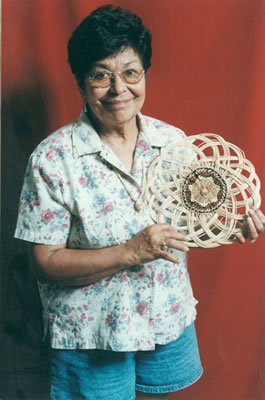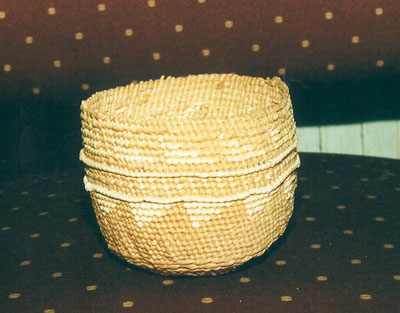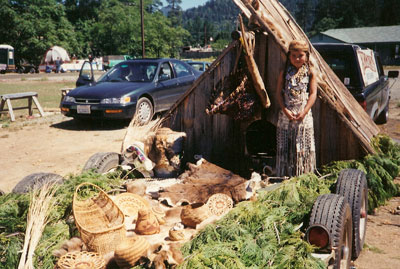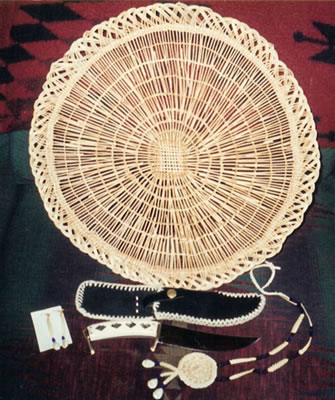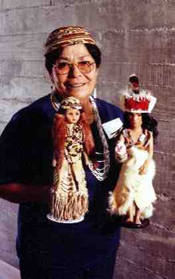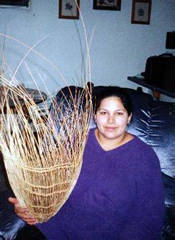LaVerne Glaze
Karuk Basketry
An experienced Karuk basketweaver, LaVerne Glaze began learning the art of basketweaving from renowned native Northern California weavers Ella Johnson and Lee Peters over thirty-five years ago. LaVerne makes many different kinds of baskets including acorn soup baskets, tobacco pouches, acorn trays, mats, fancy baskets, and small baby carriers. She is dedicated to preserving the art of basketweaving for the next generation by teaching weekly weaving lessons to local elementary school children and adult members of the Karuk community. LaVerne was also a board member of the California Indian Basketweavers Association for many years, and has worked with local government agencies to promote education about plant management to improve and preserve the quality of the natural materials essential to basketweaving.
Basketweaving has experienced a resurgence of interest over the last couple of decades and today baskets play a major role in tribal ceremonies. Basketmaking involves many skills in addition to those of actual weaving. The basketweaver must know when and where to gather the plant materials, as well as how to process and prepare them for weaving. Thus, basketry expertise requires extraordinary amounts of time, effort and specialized knowledge. Lifestyle changes during the last century put at risk the continuation of the tradition, and today that pressure continues. Eliminating the use of pesticides in the forests and knowing when and how to prune and burn, for example, are crucial to harvesting materials that are good for making baskets.
In 2001, LaVerne was a master artist in ACTA’s Apprenticeship Program, with her apprentice and granddaughter Angela Allgier. Their apprenticeship focused improving Angel’as basketweaving skills — including the gathering and preparation of the necessary willow and spruce roots, willow and hazel sticks, woodwardia and maidenhair fern, alder bark, and bear grass — so that she can participate more fully in tribal traditions and pass on to her own young daughters the importance of their culture. Angela says, “Basketry is in every part of Karuk tradition from ceremonies to everyday life. I believe wealth lies in what you know and can pass on to future generations. I would like to carry on in my grandmother’s footsteps.”
LaVerne also participated in ACTA’s Apprenticeship Program in 2006 with apprentice, Laura Sanders, who learned to weave her first full-sized acorn soup basket under Glaze’s instruction.
Select Exhibits
Demonstrations, teaching and basket showcase at the California Indian Basketweavers Gathering, 1992-present
Basket exhibits at the California State Museum, Sacramento, California, 2004-2005
Basket exhibits at the Karuk Tribal Museum, Happy Camp, California, 2004-2005
Presentation at the 27th Annual Society of Ethnobiology Conference, Davis, California, 2004
Presentations at the National Network of Forest Practitioner Annual Meeting, 2003-2004
Boy Scouts Jamboree, Washington, D.C., 2001 and 2005
Accomplishments
Advisory Council on the Historic Preservation Award to the Karuk Indigenous Basketweavers & USDA for Following the Smoke Basket Camp, 2004
Governor’s Historic Presentation Award to the Karuk Indigenous Basketweavers & USDA for Following the Smoke Basket Camp, 2004
ACTA’s Apprenticeship Programm, Master Artist, 2001
Karuk Indigenous Basketweavers & USDA Passport in Time Basket Camp, 1997-2005
Teaching Experience
Teaches Karuk basketweaving and ceremonial regalia making at Orleans Elementary School, 3rd through 8th grade, 1989-present
Teaches basketweaving to the community, students aged 7 to 89 years old
Offers field trips for gathering, processing and dyeing basketweaving materials
Professional Services
Teaching or mentorships
Demonstrations
Educational presentations to schools or community organizations
Exhibitions
Cultural consultancies

